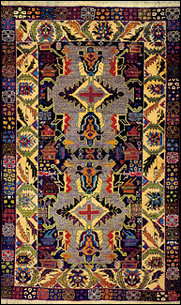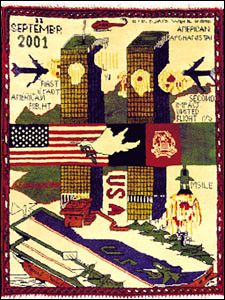Apparently these rugs have been made for decades, firstly documenting the Russian involvement in Afghanistan, and changing subtly to comment on the developing interests of the invading/occupying forces moving through. At first the weavers would just add a machine gun here or there to the traditional pattern, or maybe some mortars in amongst flowers. Traditional carpet sellers (by this I mean all those people in western countries who sell persian carpets for a lot more than they purchase them for) would't buy these carpets because they saw these images as abberations that decreased the value of the carpet.
 Tanks, machine guns, Kalashnikovs within a Persian influenced floral border, Late 1990s.
Tanks, machine guns, Kalashnikovs within a Persian influenced floral border, Late 1990s.Baluchi style, knotted woollen carpet, woollen warp, 1180 x 1985 mm, Collection Peter Bellas, Brisbane
However, even though the dealers wouldn't buy them, people still made them, and used them for their personal rugs, like prayer rugs and house rugs. In time soldiers and tourists bought them as souvenirs, and now war rugs are a whole new industry in war torn countries, and are increasingly appreciated by rug dealers. They can be found on Ebay constantly, just type 'War Rugs' and see what comes up.
They've stopped being so subtle. I find this one fascinating:

World Trade Centre, September 11, 2002, 2002, Afghanistan. Knotted woollen carpet, cotton warp, 610 x 810 mm, Collection Peter Bellas, Brisbane.
Not only because it is a comment on something that happened across the world from the maker, but because it takes a long time to make a rug like this. They're not produced on machines, they are hand-woven, by people who don't have a lot of disposable cash. And that's a lot of energy to put into a political message. I'm intrigued by them, and luckily there's a place where I can find out more about these rugs:
The authors of the catalogue decided to make war rugs their major research focus for the next XX number of years, and are planning further exhibitions. They've been writing a brilliant blog documenting their research and asking for contributions. It's well worth a read, and the rugs themselves are absolutely stunning. Check it out.
6 comments:
those are incredible. thanks for the post.
Just noticed your new .com space! I've been meaning to tell you about a blog I read that you might like, also: it's called adminicle , at http://andreweason.typepad.com/ . Andrew is a book artist in England.
Mmm, do like him
And his blog looks great, will look closer when I get away from being someone else's slave for the day (which is the nicest time to blog-play).
thanks!
Fascinating.
That is the most interesting blog post I've read in ages. I had no idea about these - they're such a beautiful, interesting way of documenting history.
Not the sort of thing you'd use as a lap rug when you're curled up on the couch with a novel, though, is it?
Thanks Rubydot!
No, not lap-rug material, but these are real rugs that can be walked on and sat upon in front of a toasty fire.
One of the blog authors has a house full of them, and his office lined with them, and we walk all over them when we visit. I think they are just spectacular. They make me think of the people who made them much more so than 'normal' Persian carpets...
Post a Comment